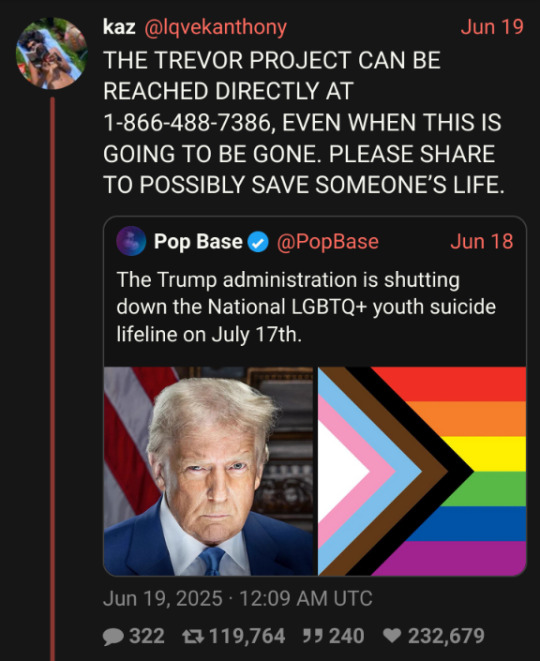BE CAREFUL!! I POST OUTER WILDS: ECHOES OF THE EYE SPOILERS! Viewer discretion is advised! I'm currently going through a tremendous Outer Wilds brainrot so bear with me
Last active 2 hours ago
Don't wanna be here? Send us removal request.
Text

I did it your honour, all my hearthian OCs have their updated references ready for Art Fight! Yippee! Here is Mohs, my first Outer Wilds OC - refreshed and updated! They're a geologist and co-founder of the Outer Wilds Geological Survey!
Also, for funsies, check out how much my style has changed in the past year! I first finished Mohs' original reference a year ago yesterday! I'm so happy with how much Outer Wilds has pushed me to improve my work - sometimes we just need that category 7 event, huh?

60 notes
·
View notes
Text
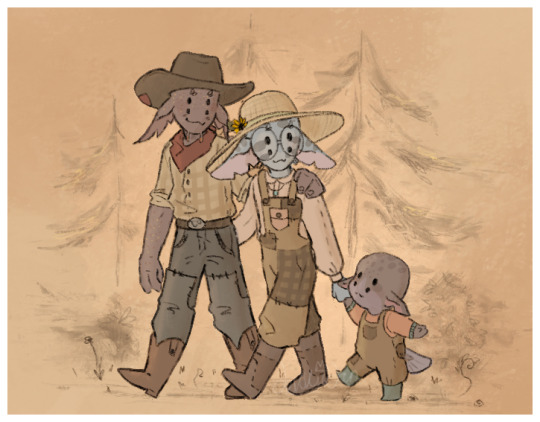
Little family doodle of Dusty, Mohs and Pip out for a little walk around the Ranch!
the irony that my birthday is on Father’s Day paired with the fact I am extremely paternal atm is not lost on me lmao
94 notes
·
View notes
Text
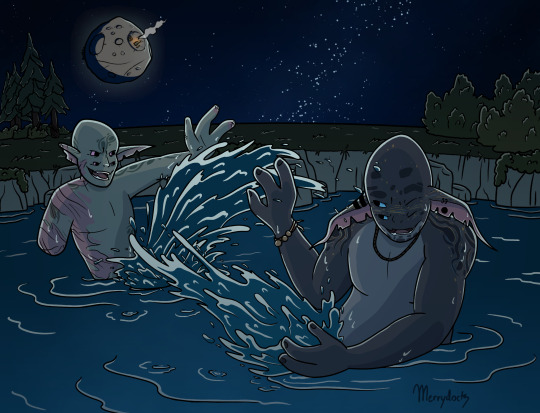
Mylo and Stein are having some summer fun at the Lake! The old fish deserve to be silly sometimes, too. Stein definitely needs a break after working at the bar all evening, and Mylo....just wants to have a water fight, lol.
Happy birthday, @dekkiidan!
59 notes
·
View notes
Text

Dusty taking a nap whilst out with one of their Fellers :3
little doodle for part of Dusty’s Art Fight ref!
drawing a creature with six legs laying down was certainly interesting hehe
44 notes
·
View notes
Text
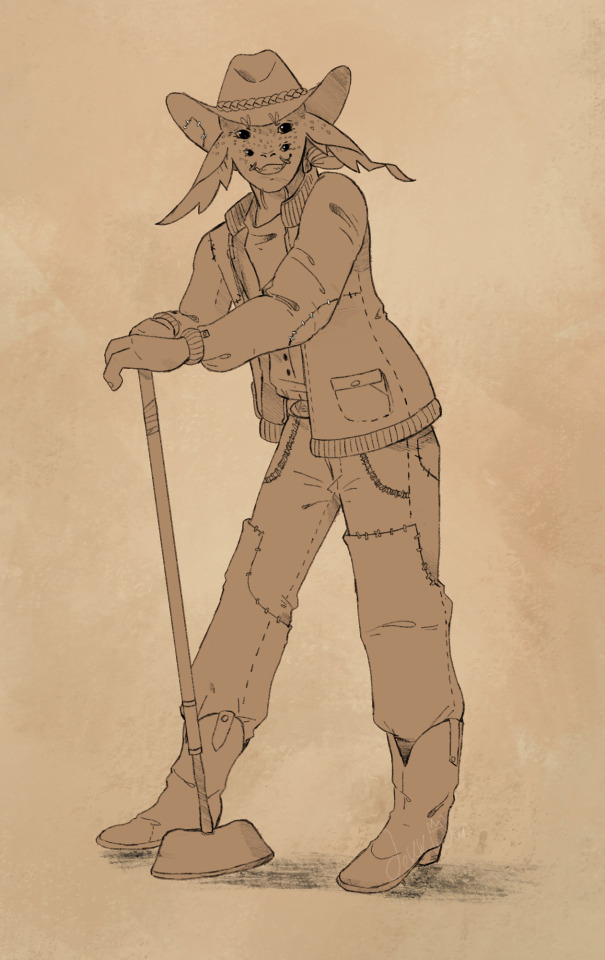

First piece of art using my new tablet, featuring Dusty and they hoe. Couldn't decide if I liked just the lines or the flat colours better >::3c
Drawing straight to a screen is so nice, I feel like a whole new world of art has been unlocked!
62 notes
·
View notes
Text
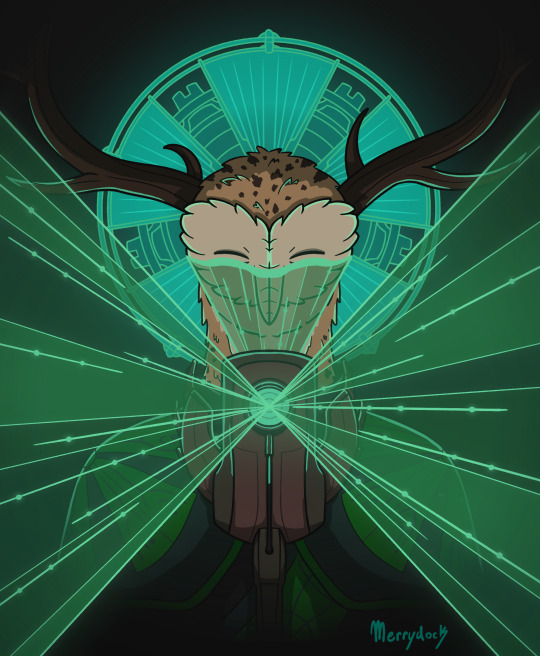
Some old art of my Owlk engineer, Eris, designing the Stranger's solar sails! Enjoy a big ramble about him and his job because I love this silly man:
Eris works on the design team for the Owlk space program, specialising in energy and propulsion technologies for the ships, satellites, and probes. Having a design philosophy of functionality and beauty, Eris enjoys going all-out with his work. He has received special recognition for his solar panel designs in particular, which borrowed from the unparalleled efficiency found in photosynthesizing plants.
When designing the Stranger's solar sails, Eris took inspiration from plants, but also the opening of insect elytra; the ballooning behaviours of silk-producing invertebrates, in which they sail from tree to tree using electric fields and air currents; and how flying creatures will use thermal updrafts to soar higher while expending less energy. Already familiar with how solar energy impacts technology from his work on solar panels, he proposed the use of this energy to propel the Stranger through space.
As travelling the distance between stars presented the major roadblock in the plan to reach the Eye (regarded as the Interstellar Propulsion Problem), Eris was lauded for his contributions, promoted to being one of the main engineers overseeing the Stranger's design.
More information about his general design process below!
When designing for a project, Eris uses all of the tools at his disposal. His first weapon of choice is always his pencil, and he will sketch out potential sources of inspiration on paper until the design concept begins to take form. Based on the initial project parameters he's been given, he drafts up a blueprint for his components.
Next, he must further conceptualise his designs. This is where the most valuable tool of the trade comes into play—the Vision Torch! Vision Torches serve many purposes for Owlks, from allowing them to nonverbally communicate to creating photographs from memory alone. Owlk engineers LOVE Vision Torches for how easy they make effectively communicating ideas. They allow concepts to be visualised in 3D, basic functionality to be shown through animations, and are even able to interface with computers. Eris might even 3D print a model using a Vision Torch to help him visualise his concepts as he works.
The space program is extremely collaborative, and Eris works on just a small part of the overall project, so being able to easily share ideas with others and see how all the individual components of a satellite or ship interact is vital. When discussing with more than a single other Owlk, Eris can use a Vision Torch linked to a holographic display to present concepts to a crowd. Concepts can also be tweaked in real time this way!

[Here's an example from the game of Owlks building the simulation with Vision Torches and a holographic display!]
With a Vision Torch, concepts can also be directly uploaded to a computer terminal. This is where a lot of the real work gets done - calculating weight, materials needed, stress testing in simulations, calculating trajectories, making precise tweaks to finalize the design, you name it. This also allows other Owlks working closely with Eris to access the most current design for their own tests.
This is an iterative process - as other Owlks finalize their components, as weight limitations are further restrained and material needs are calculated, Eris often has to go back to an earlier step and rework his concept. Fortunately, he thoroughly enjoys getting to be creative in his work (and doing math) and treats every project as a puzzle that needs to be solved! The only time when he's not excited to go back to the drawing board is when a last-minute adjustment from his peers means he needs to work long hours to get his work done in time for launch.
#AAAAHHHHHHHHHHHH#MY DARLING SON IN LAW#outer wilds#outer wilds owlk#echoes of the eye#i will tell him to take a break and I will gently hold he#i will give him maple bacon
69 notes
·
View notes
Text
Hello everyone! I have been working on this project for many, many months, if not a whole year by now -- but it is finally here! And so I present to you yet another documentation project:
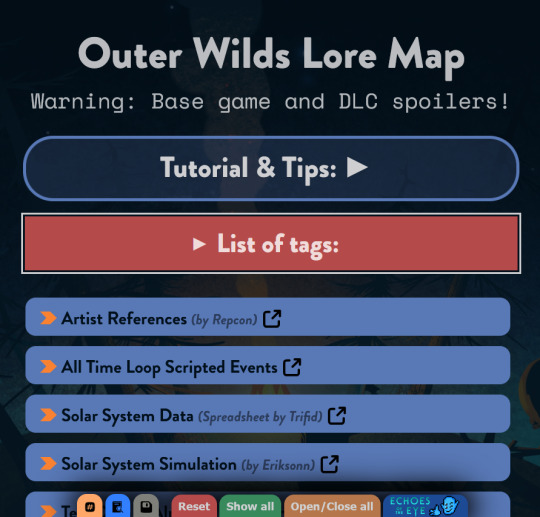
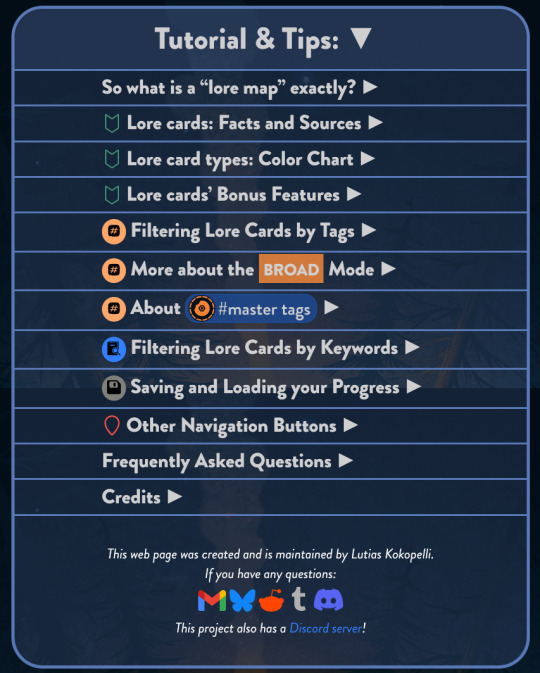
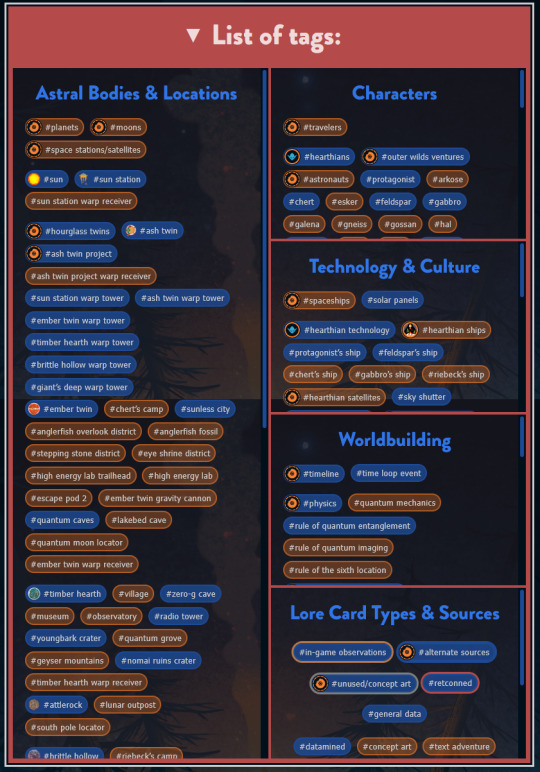
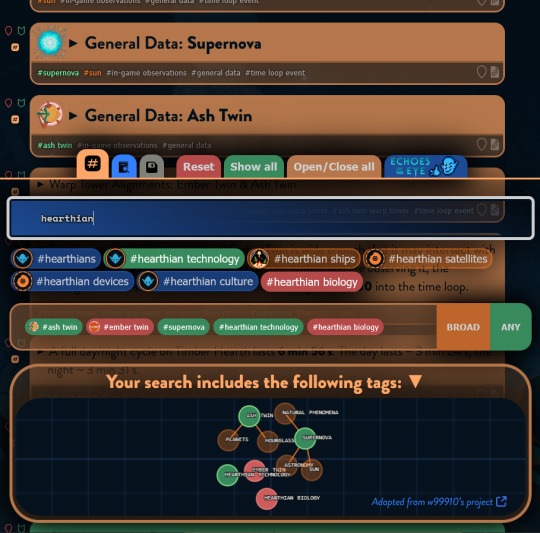
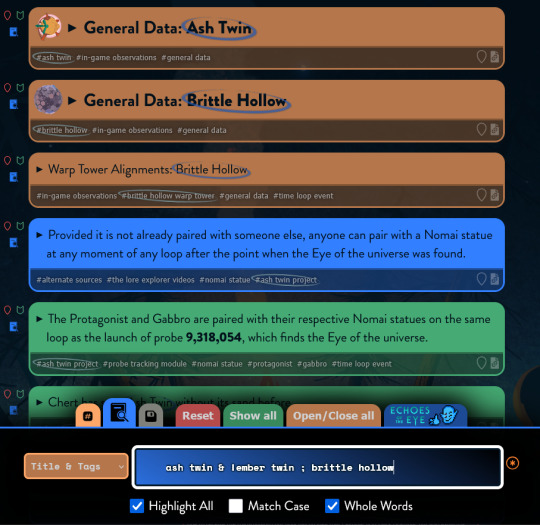

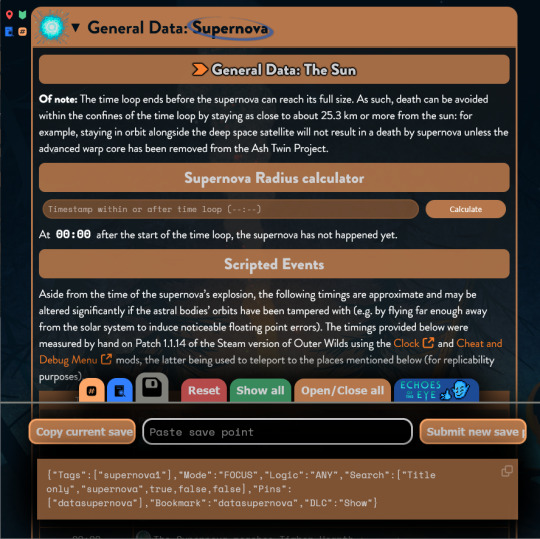
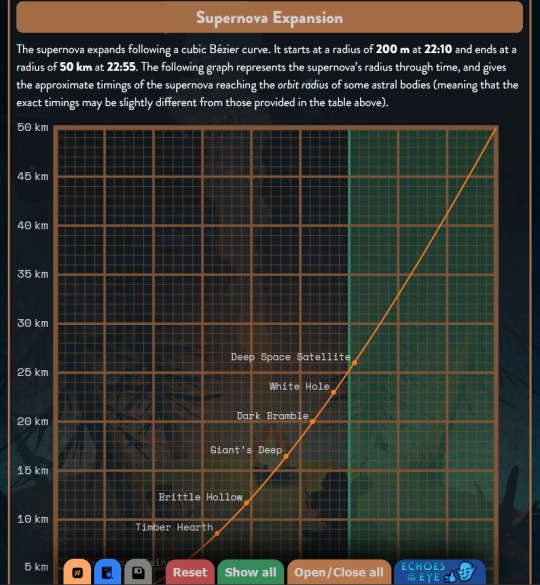
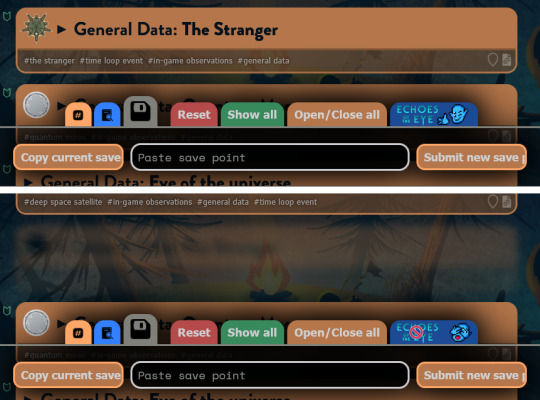
The Outer Wilds Lore Map aims to be one big interactive web page containing as much of the OW lore as possible -- from physics data about how big (small, really) the planets are, to obscure fun facts about lore that could have been but was removed or retconned at some point, to whether or not Chert knows what Ash Twin looks like without its sand!
I have already spent a very long time writing it all in the tutorial and the coding itself, so I will rather let the images speak for themselves here. All I will say is that I have done everything I could in order to make it as intuitive and comfy an experience as possible. The lore is very lacking for now, and filling it will take a while -- but hey, wouldn't it be fun to do it with friends? If only in order to have people nag at me for all the typos, or if you disagree with something.
You want to help out? Just curious? If you're interested, there is a Discord server that you can join in order to give your thoughts on where this is going!
The link for a permanent invite is present on the Lore Map's page, just open the blue "Tutorial & Tips" button and look at the bottom!
204 notes
·
View notes
Text
it all started with the first art. but i dont know how to animate so just smple slide show lol. practice ig
долги по учебе хуячат меня в задницу но я выбрал быть счастливым
below frames i might like




#holy babaloney in a bowl of macaroni what in the world#this is SO GOOD???#WHAT#outer wilds#outer wilds spoilers#ow
63 notes
·
View notes
Text
What is a Rock?
Hey folks!
Before we get started with sharing our full survey notes, we thought it would be a good idea to go over some basic terminology.
What is a Rock?
No, seriously! What counts as a “rock”? Geologically speaking, a rock is a solid, naturally-occurring collection of minerals and other materials. It might be made of a single mineral type, or multiple, but it is an aggregate of many individual mineral crystals.

Fig. 1: An image of a coarse-grained granite showing individual crystals of feldspar, mica and quartz. Note that the entire rock is made up of these interlocking individual mineral crystals.
What is a Mineral?
A mineral is a building component of rocks, and has a very specific definition based on particular criteria that must be met. For something to be considered a mineral, it must meet all the following criteria:-
It must be solid
It must be naturally-occurring
It must be inorganic
It must have a definite and known chemical composition
It must have a defined crystal structure
What does this actually mean? Let’s walk through it. Criterion one discounts anything that is a liquid - such as water. As you know, rocks and minerals can become liquid when exposed to high temperatures, magma and lava for example, but in this form, they are not minerals! They can only be classed as minerals once they solidify, provided they meet the other criteria alongside.

Fig. 2: Image of lava (a non-mineral due to its liquid form) and basalt (a rock made up of minerals).
As for the other criteria, naturally-occurring and inorganic are self-explanatory. No crystals that can only be manufactured in a laboratory setting are true minerals, because they cannot exist in nature! Crystals that are commonly lab-grown but can exist in nature (such as moissanite) still count as minerals. Inorganic means the mineral can be formed by inorganic processes. Something like calcite can be produced by animals (such as clam shells) but can also be formed by geological processes without the involvement of any living thing. This actually discounts amber as a mineral - since it is tree resin and is not replaced by any other minerals as is the case with fossilisation - therefore amber is not a mineral!
Having a definite chemical composition is also pretty much what it sounds like - it needs to have a chemical formula - a sequence of elements organized to form a compound that we know the definite composition of. For example, the chemical composition of quartz is SiO₂, which means it is a compound made up of atoms of silica and oxygen. Similarly, the composition of potassium feldspar - KAlSi₃O₈ is made up of potassium, aluminium, silica and oxygen atoms.
Lastly, a mineral must have a crystal structure - but what is a crystal structure? The simplest way to imagine this is with building blocks. Each block is the unit that defines the chemical composition - for example, SiO₄ for quartz. So, one “block” of quartz will be a unit of SiO₄. By arranging these blocks in a repeating pattern, a larger structure begins to take form. Crystals are orderly structures - imagine the blocks are piled nicely on top of each other, this is why many crystals have such well defined shapes!

Fig. 3: Diagram showing the atomic "building block" structure of quartz using a 3D model and ball-and-stick diagram; diagram showing "building blocks" arranged in the natural crystal structure; image of a quartz crystal - note the same crystal structure!
Something like glass, or a naturally-occurring glass, like obsidian, has these blocks arranged randomly, like if you were to take your tower and throw it into a storage bin. Because obsidian lacks this order on an atomic level, it isn’t considered a true mineral!

Fig. 4: Image showing a fragment of obsidian. Note the conchoidal fracturing on the obsidian - this is caused by the lack of organisation in its structure.
Unfortunately, we aren’t going to be able to run any chemical analyses in Outer Wilds, but we’ll do our best to compare what we see to real-world rocks, minerals, and features, and hopefully this will be able to steer us in the correct direction regarding some of these criteria to ensure we are analysing true minerals, and therefore, true rocks!
What is a Fossil?
Now, we just said that minerals and rocks can’t be organic, and you’re probably thinking, well hold on a second, what about fossils? How can something that was organic become a rock?
Let’s start by defining what a fossil actually is. Fossils are described as “any preserved remains, or trace of a once-living thing.” This includes anything from the fossilised skeletons of dinosaurs, to the delicate imprints of leaves and plants. Now, it’s important to note that not all fossils are rocks. Objects preserved in amber, for example, are classed as fossils - but as they remain organic, and cannot be classed as a rock.
How do we go from something organic, like a bone, to an inorganic version of it? Probably the most well known form of fossilisation is via replacement - where organic remains are replaced by inorganic minerals. Most bones are made up of calcium phosphate and other organic materials. When an animal dies and is buried by sediment, these organic materials are replaced by inorganic crystals in a process known as permineralisation. Permineralisation occurs when the pores of the original specimen are infilled with mineral matter from the ground or water - which then, bit by bit, replace the original organics with minerals, eventually completely replacing the whole specimen! When this occurs, you no longer have your original animal bone, but instead a replica of it with a completely inorganic composition - a fossil! The minerals involved in replacement can vary widely, which can produce spectacular finds such as these pyritised ammonites, or opalised vertebrae!

Fig. 5: Fossilised remains of two opalised Iguanodon vertebrae; a pyritised Ammonite.
Other fossils, such as footprints and burrows provide a record of an organism’s life, as opposed to actual remains of the organism itself. These fossils are known as trace fossils and are normally impressions that have been made in soft mud/soil that has then lithified. The cool thing about trace fossils, and especially footprints, is that you’re left with a cast of whatever part of the creature made contact with the substrate - sometimes with incredible detail of footpads, claws, and/or skin. A trace fossil is also completely inorganic, as it’s simply an imprint of a creature, and as such, technically classes as a rock!

Fig. 6: Photograph showing a dinosaur footprint mould and a dinosaur footprint cast. Both of these are trace fossils and have been formed via sediment infilling and lithification.
Alright, there was a lot of information there, but hopefully it has provided you with a strong foundation and understanding of what actually makes a rock . . . a rock! In our next post, we will be diving into the different rock types and the funky structures and features that they can create!
Hopefully, you’ll soon be able to start identifying a variety of rocks in your own Outer Wilds adventures!
If you have any questions regarding what we have talked about here, or indeed just about the Outer Wilds Geological Survey in general, please don't hesitate to drop us an ask!
Catch you in the next loop! The OWGS Team
71 notes
·
View notes
Text

Valleys drop, mountains rise Lift your head, brave the skies You think it's gone, my friend But it comes back again
ID: Outer Wilds fanart inspired by Klimt’s “The Kiss”. The two figures in the painting are represented by the protagonist and the Eye of the Universe. The protagonist is wearing their suit and kneeling, holding one arm up to cradle the Eye’s symbol, which is shining brightly and extending to the edges of the image. They are both surrounded by a quantum shard. The rest of the travelers are in the background, framing the image. From left to right: The Prisoner, Feldspar, Solanum, Gabbro, Riebeck, Esker and Chert. The light from the Eye’s symbol is reflected in everyone’s helmet or their eyes. End ID
322 notes
·
View notes
Text









Outer Wilds Ventures Photocards !!
(etsy hehehe)
Here's how they look all nice and printed out :3

306 notes
·
View notes
Video
guys shut the fuck up this is the only thing im gonna talk about for the rest of all time
(publicly shared video of a sweetheart’s dance from Rodney Stanger on fb)
193K notes
·
View notes
Text
Meet the Founders: Mohs
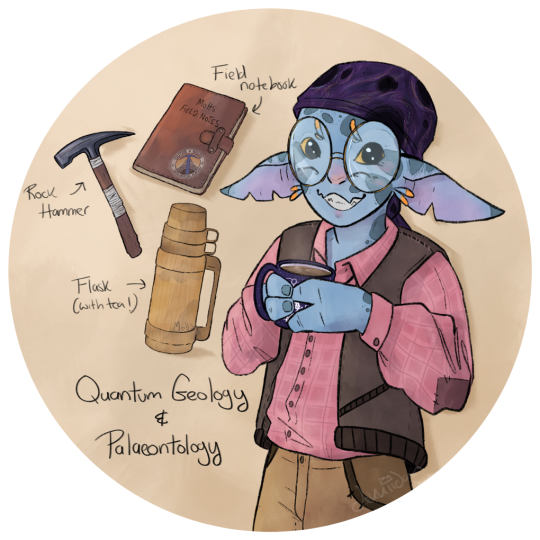
Outer Wilds Geological Survey Founder: Mohs, drawn by @dekkiidan Howdy! Thanks so much for stopping by the Outer Wilds Geological Survey database, it's always great to know there are folks out there interested in the amazing stories and secrets that our local, and not so local, geology can tell us!
Anyways, I'm Mohs - nice to meet you! I'm one of the founders of the survey alongside my good pal and esteemed colleague and pilot, Lari. Ah, yeah, most folks already know, I'm not a fan of flying . . . but that's why Lari is our pilot and not me. Besides, how can I solve the mysteries of the Quantum Shards with only the samples we have on Timber Hearth when there are more outcrops out there waiting to be analysed? Conclusion:- I can't! Unfortunately. And, you know, Lari hasn't crashed us! No yet, anyway.
Geology wise, my main areas of expertise lie in what most folks would call laboratory and technician work, so things like sample and specimen prep, sorting out thin sections for microscopy, and sawing large samples to get a nice clean surface for proper observational analysis. This is why you're more likely to find my in the museum prep. room than out in the field. Don't get me wrong, I love field work too, especially when Lari and I are wrangling a particularly tricky outcrop, or if there are fossils involved; but somebody has to ensure the survey sample and field note collections are properly organised, analysed and documented. And, I'm not sure if you've ever seen Lari or Hornfels' own collections, whether that be geological, astronomical or research based, but - well let's just say, I don't think they're the right hearthians for keeping things organised. Sorry Lari! Sorry Hornfels!
I'm also currently working on a research paper and presentation regarding Quantum Geology that has recently come along in leaps and bounds thanks to Hal and the hatchling's translation tool titled -
"Quantum Geology: A morphological mystery, or lost in translation?"
Because, you know, based on some of the latest translations, I really don't think the Nomai fully understood the complex nature of these curious shards, and I would love to crack the mystery of their formation and origins!
Ah, apologies, I got a little carried away there, heh! Well, if you ever have any questions, don't hesitate to get in touch with either of us, we'll do our best to shed some light on the mysteries and puzzles of the amazing geological history of our solar system! And if you have any questions about Quantum Geology, or even want to share theories, I'm all ears!
Thanks again for stopping by!
57 notes
·
View notes
